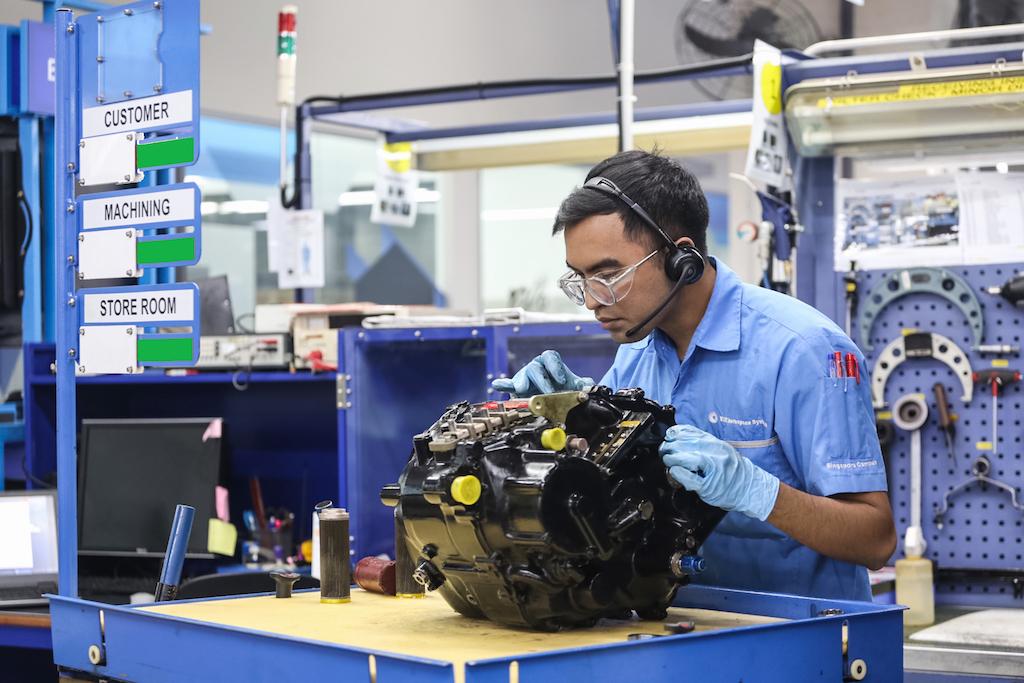
Collins Aerospace has officially launched its 10,000-sq.-ft. Singapore innovation hub at its Changi MRO campus. The hub, which aims to deliver more than 40 proofs of concept over the next five years, will lay the groundwork for what the company calls “the Collins MRO shop of the future.”
According to Bob Butz, VP and general manager of global repair services at Collins Aerospace, the hub will focus on innovation segments such as sensing, machine learning and robotics and automation engineering to address customer pain points like inventory management and parts availability. The hub will initially focus on three major solution areas: customer connectivity, integrated operations and digital tools.
Butz says the customer connectivity component will reflect the simplicity and transparency of the typical online shopping process. “The goal here is to really enable speed and ease of the interaction between the MRO shops and the customer,” he explains. “We find the same approach will lend well in the aerospace industry, particularly around the repair business. We’re working toward a similar experience leveraging our customer portal system for automated, agile and actionable data.”
Key threads within this area will include providing customers with proper documentation of asset repairs, digital part history and real-time insight into repair scope. Customer connectivity solutions will also integrate physics-based modeling, statistical analysis and machine learning into advanced prognostics and health management applications – such as what Collins provides through its Ascentia platform – to provide customers with data for strategic maintenance decisions.
“What we’ve found is the early adopters of this activity are really seeing approximately 30% reduction in delays and cancellations, and more than a 20% reduction in unscheduled maintenance,” says Butz. “This will have a real, tangible impact for the customer.” He adds that these types of insights will foster better customer communication and collaboration with MRO shops.
The second focus area for the innovation hub, integrated operations, will revolve around automating back-end processes at Collins to drive efficiency. The company plans to leverage technology such as optical character recognition for inputting work and purchase orders, robotic vehicles for transport of parts through the shop and RFID (radio frequency identification) for parts tracking. Butz says these technologies will ensure efficient product delivery, separation of abnormal products and continuous availability of product data for customers.
The hub’s last focus area, digital tools, seeks to connect the customer interface and integrated operations by using architecture and statistical analysis to place data together in the most useful way.
“Back in the day we used to have 12 or 13 TV screens to make up a big picture. That is very analogous to what we see here in repair shops. They have 10 or 13 screens they have to open up to actually work a part through the process,” says Butz. “Now we have it in one integrated screen that really takes the data and puts it in a way that they can make really insightful and informed decisions, and take action more efficiently.”
Once proofs of concepts are generated and matured within the innovation hub, Collins will develop them for scale for roll them out across its network – first at its centers of excellence before implementation at its 77 MRO shops worldwide. Butz believes some solutions have the potential for expansion into Collins’ more than 300 global factories as well.
The hub has already started on a number of projects since its soft release last year, and Collins has hired approximately 10% of the 40 employees it plans to add. By year-end, Butz expects to have filled more than 80% of the roles, depending on the nature of projects coming through the hub and how quickly they scale.
The innovation hub will also become one of Collins’ three centers of excellence for additive manufacturing capabilities and techniques, as well as its first additive facility with titanium capability.
